Gerbera Daisies are perennials but grown as outdoor annuals in areas that experience temperatures below 0°C. Whether grown in beds or pots, regular fertilization schedules are required to ensure plants can best bloom and plant health continues. Soil fertility is the most amazing way to impress Gerbera Daisies is in their unfolding performance. Let’s check out the best fertilizer for Gerbera Daisy.
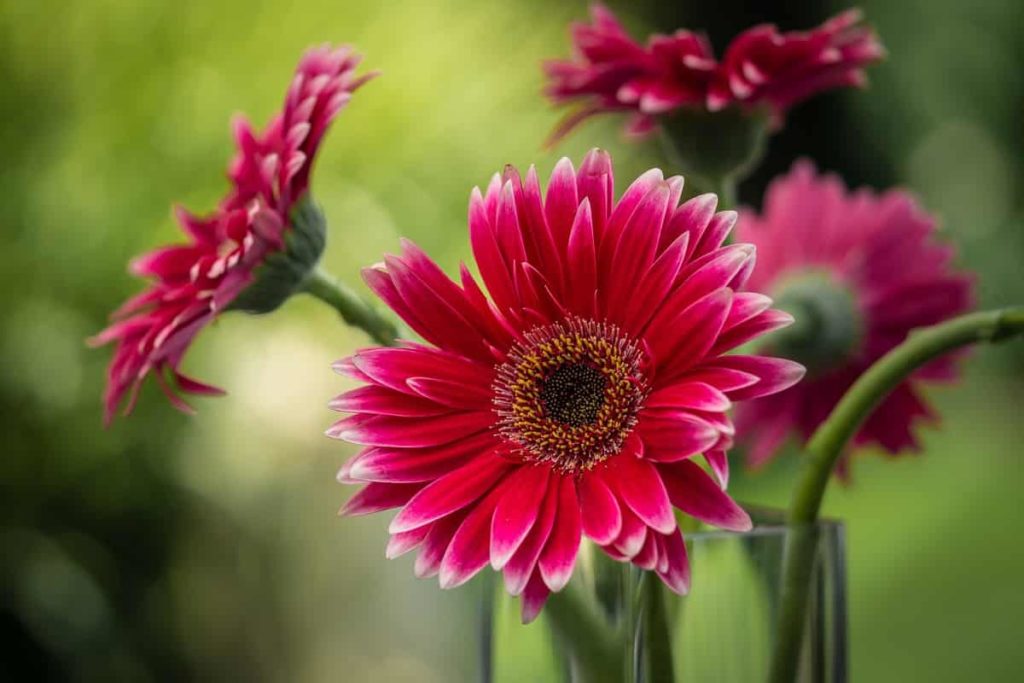
Soils lacking balanced nutrients such as nitrogen, phosphorus, and potassium affect bloom for most flowering plants, including Gerberas. In addition, Gerbera Daisies also require extra magnesium and iron to provide a continuous bloom. Using NPK fertilizers, including at least one of two trace minerals iron and magnesium is best. Unless you are using controlled-release fertilizer, which lasts longer feed the soil in which your Gerberas are growing once a month.
Nutrients needed for Gerbera to grow and bloom
- Nitrogen – It helps in root and steam growth and provides a strong foundation for the plant.
- Phosphorus – It helps the roots to absorb nutrients better.
- Potassium – It protects the Gerbera from diseases and helps in Gerbera color.
- Magnesium – Helps plants to process sunlight better.
- Sulfur – Provides Gerbera with extra protein, which is essential for a strong life.
- Iron – Helps to have a strong foundation of Gerbera.
- Manganese – Helps in the Gerbera growth and process of sunlight.
Best fertilizer for Gerbera Daisy
Homemade fertilizers for Gerbera Daisy
Homemade fertilizer can be as easy for gardening as using the organic refuse readily available within the home setup. Similarly, the nutrients of common commercial plants such as nitrogen, phosphorus, and potassium can be purchased separately and mixed with a specific proportion at home to develop a good formula that will boost the growth of Gerbera Daisy.
In case you miss this: Growing Gerbera Daisy in Pots – a Full Guide
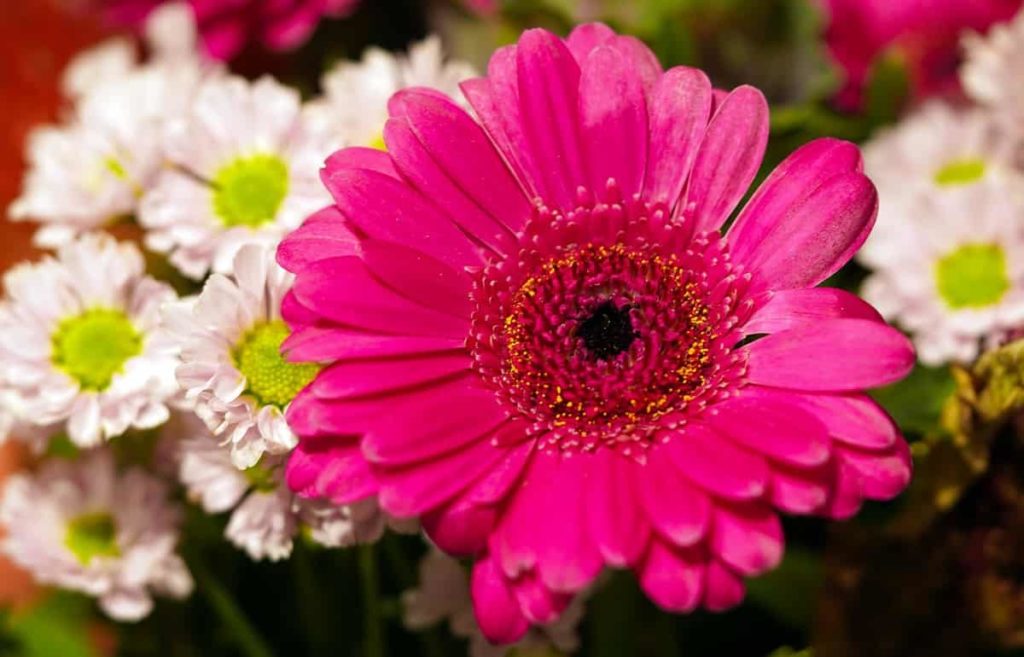
Coffee grounds
Coffee grounds contain nitrogen, calcium, potassium, iron, phosphorus, magnesium, and chromium also coffee grounds are abrasive, so the barrier of fields placed near your Daisy plants can protect them from slugs and snails. Large amounts of caffeine are toxic to slugs, and in small amounts, it can slow them down. Also, the mere smell of coffee prevents slugs and snails.
Banana peels or onion peels
You can use banana peel or onion peel fertilizer during flowers. This will increase rapidly and increase the size of flowers.
Compost manure for Gerbera Daisy
Compost
The soil in which these flowers are to be planted has many benefits of manure fertilizer, and this is the first step to ensure that Gerbera Daisy is well taken care of. With organic fertilizer in the soil, micro-biology activity increases. While organic fertilizer sits a wonderful job in enabling Gerbera Daisy to flourish, on the other hand, commercial fertilizers have their exact applications.
In case you miss this: Growing Hydroponic Gerbera Daisy – A Full Guide

So, to provide an ideal homemade fertilizer is to buy the nutrients of these commercial plants and then mix them based on the objectives that they have to offer once in use. Nitrogen generally helps enrich plant leaves, phosphorus promotes the growth of flowers and fruits, while potassium improves plant trunks and roots.
Vermicompost
Vermicompost is a nutritious organic fertilizer and soil conditioner which is relatively easy to absorb for plants. worm castings are sometimes used as organic fertilizer.
Organic and liquid fertilizers for Gerbera Daisy
Fish emulsion or seaweed mixture
Provide your Gerbera Daisies with a high-quality micronutrient-rich liquid plant fertilizer. Both fish emulsion and seaweed are well-advised.
Compost tea
Compost tea reduces nutrients, making it easier for plants to use faster. It also helps the soil to maintain water, reduces fertilizer use and attendant salt accumulation, and improves soil pH to levels that encourage nutrient and moisture use by plants.
In case you miss this: Bamboo Polyhouse Construction: Design, Subsidy, and Cost in India
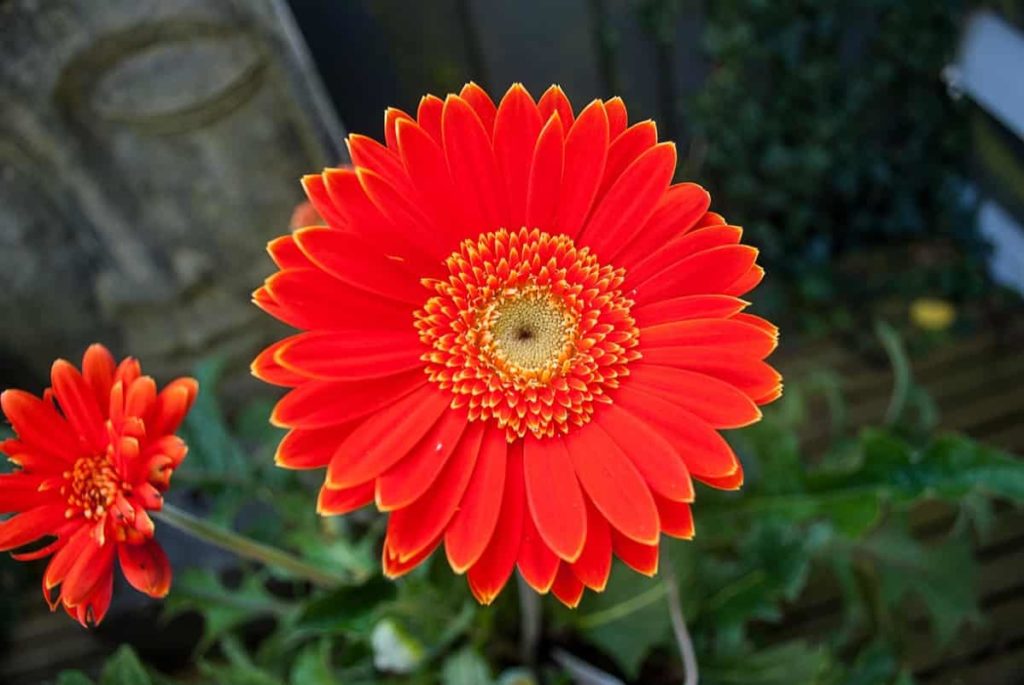
Alfalfa meal
Alfalfa meal act as a slow-release fertilizer, a great source of nitrogen. It is beneficial for adding nitrogen, phosphorus, and potassium as well as tracking minerals and contains triacontanol which is a natural growth stimulant. Microorganisms present in soil take advantage of this and also benefit from plants and create more underground activity by providing food for them.
Kelp Meal
The use of kelp meal for plants is not only a good idea as it is a natural fertilizer, thus nourishing the plant, but it also encourages your plants to extract nutrients more effectively from the soil in general.
Bone meal fertilizer
Bone meal fertilizer makes your plants a fantastic organic compost to supply vital nutrients like calcium and phosphorus, promoting strong, healthy plants and production. Soil testing is essential before fertilizing bone meal in your garden. This will help you determine whether this is the right choice for your soil.
Commercial fertilizers for Gerbera Daisy
NPK ratio
Gerbera should be fed with a fertilizer based on nitrate and not ammonium. While ammonium-based fertilizer promotes large leaves and more shading. The first fertilizer application should be applied about 10-14 days after germination using formulas like about 75-100 ppm nitrogen 15-5-15. Avoid applying fertilizer directly to the leaves if the leaves are soft.
Otherwise, wash Leaves with fresh water after each fertilizer is used. Formulations that provide excess potassium, such as 15-3-20, forms strong plants with a total count of high flowers. Feed plants every two weeks with water-solving fertilizers, such as a 24-8-16 formula.
In case you miss this: Top 10 Flowers to Grow in Pots
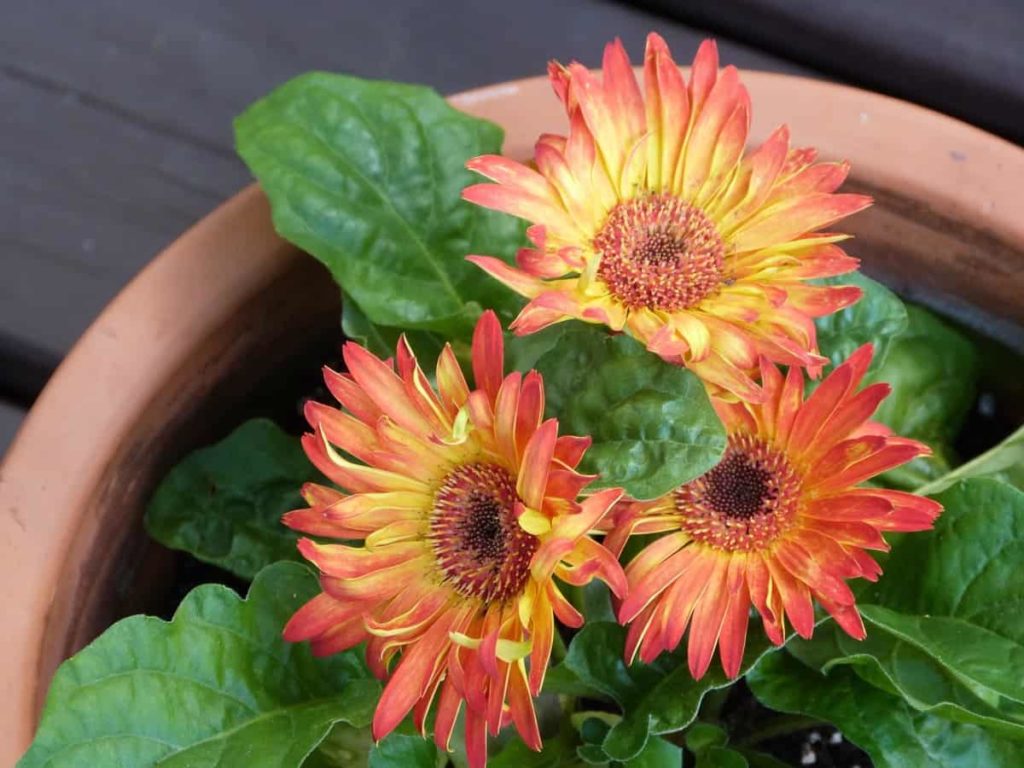
Micronutrients
Iron
Soil pH above 6.2 can cause micronutrients like iron to be unavailable for Gerbera. Iron chlorosis often results when this happens. The main symptom is the gradual yellowing of young leaves of plants, which does not change the green veins. Spray Gerbera leaves with chelated iron and switch to more acidic fertilizer, such as 20-10-20.
Calcium and manganese
If soil pH is less than 5.5 it can be problematic for Gerbera, as it often causes calcium and magnesium to be tied to the soil. Calcium deficiency causes blossom end rot and distorts the growth of new leaves. Spread calcium nitrate on Gerbera in small doses until you start seeing improvement in plant condition.
Magnesium
You don’t need a test to see if your plants need magnesium. Lack of magnesium causes the leaves of the old Gerbera to turn yellow around the edges, leaving the green center of the arrow-shaped. This can also be treated. Mix about 28 grams of Epsom salt in 5 gallons of water. Apply this solution weekly to your Gerbera bed.
Gerbera Daisy fertilizer schedule
- When you should fertilize Gerbera, it depends on the Gerbera (annuals or perennials), when Gerbera blooms, and the fertilizer you use. After planting, start showing fertilized garden Gerbera Daisies or once perennial plants new growth in spring. Apply slow-release, low phosphorus fertilizer, such as 15-5-15, at the rate recommended on the package for your bed size.
- Water the plants immediately after fertilizing, rinse the leaves with water. The leaves are easily burnt by contact with fertilizer.
- Fertilize for the second time two months after the first application. Apply for a third application two months after the second application.
- Spray the Gerbera Daisies with iron foliar spray in the middle of summer if the leaves start to yellow. Gerbera Daisies is iron deficient. Follow the instructions on the spray label for proper application procedure and amount.
- Gerberas may suffer from iron and manganese deficiencies, especially in potting soil; therefore, use a granular fertilizer or foliar manure spray to contain these micronutrients.
How to fertilize Gerberas in pots
Gerberas should be planted in a well-draining potting mix that includes part perlite and part coarse sand. They may suffer from root rot and will not survive in soggy conditions. Feeding plants once a month with high potassium fertilizer will encourage plentiful blooms. You can use a mixture of potting soil regularly, but we recommend making it a little sandy. This will maintain more moisture and ensure a humid environment where Gerbera Daisy can thrive.
Gerbera Daisies benefit greatly indoors from monthly feeding with fertilizer for houseplants or blooming plants during warm months. Do not compost during winter or fall, as your Daisy will be inactive and won’t help. Garber Daisies benefit from monthly doses using regular fertilizer for household plants or blooming plants during spring and summer.
In case you miss this: Top 20 Flowers To Grow In Hydroponics
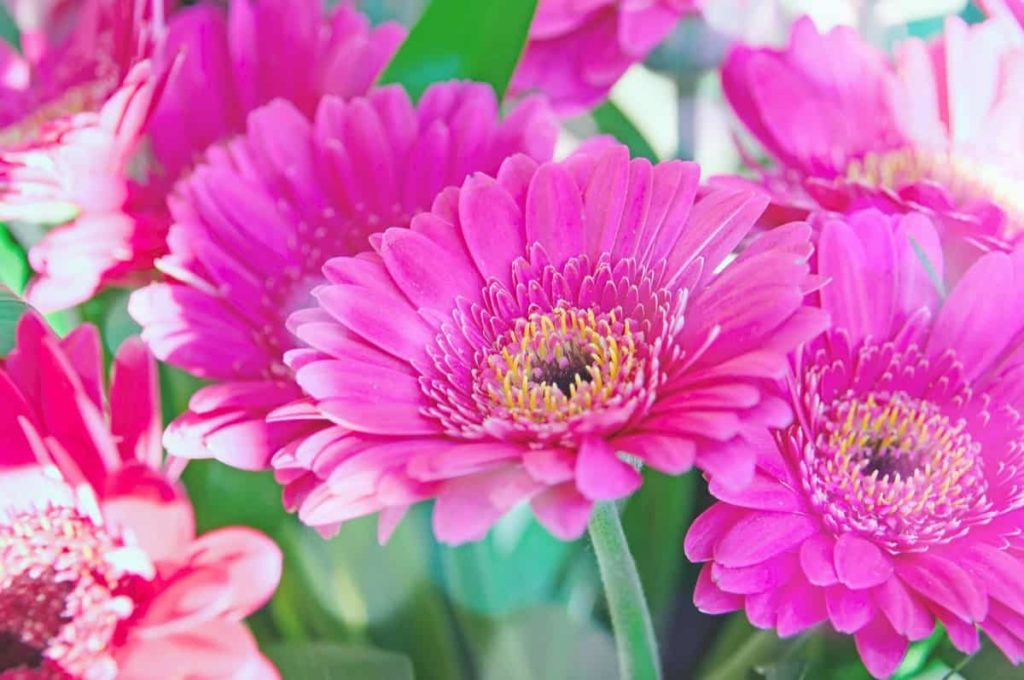
For indoor plants, it is better to use a fertilizer that is formulated for blooming parts. Follow the package instructions on how much fertilizer to use based on the size of your container. Fertilize your Gerbera during the growing season (mid-spring to early summer) but avoid doing so.
Frequently asked questions about fertilizers for Gerbera Daisy (FAQ)
Can I use Miracle-Gro on the Gerbera Daisies?
An all-purpose fertilizer, such as Miracle-Gro water-soluble all-purpose plant food, will be well suited to your Gerbera Daisies.
How do you make Gerbera Daisies bloom more?
Compost with a water-soluble fertilizer every two weeks with a small quantity of phosphorus (e.g., 15-7-15 or 12-2-12). This will help in blooming and not in the growth of leaves. Gerberas will not bloom continuously. They bloom, then take a break of about two weeks to refuel then bloom again.
Why are my Gerbera leaves turning yellow?
Gerbera Daisy leaves can be yellow due to excessive water or too much water in the soil. Too much water can result in root rot, and nutrients will not be absorbed from the soil. This can weaken plants and result in yellow, brown, or red leaves.
Why are my Gerberas have short stems?
Like most annuals, Gerbera Daisies are heavy feeders, make sure to fertilize regularly. Cold temperatures, dry conditions, or high salt intake can also cause flower stems to shorten.
- How to Grow Tomatoes Organically at Home: A Comprehensive Guide
- Organic Gardening on a Budget: Low-Cost Methods and Materials
- Gongura Seed Germination and Planting Methods
- Cabbage Seed Germination and Selection
- Broccoli Seed Germination and Selection
- Asparagus Seed Germination and Variety Selection
- Seasonal Flower Gardening: Best Practices for Spring, Summer, Fall, and Winter
- How to Grow Hibiscus from Flower
- Plantation Ideas for Home Decoration: A Beginners Guide
- Flower Garden Designs and Layouts for Beginners
- Planting and Spacing Techniques in Papaya: A Beginner’s Guide
- Growing Gold: Essential Techniques for Planting Pineapples
- How to Make Kalanchoe Plant Bushy: Home Remedies and Solutions
- 11 Reasons Why Your Gardenia is Not Blooming: Home Remedies and Solutions
- Eco Elegance: The Guide to Designing a Drought-Tolerant Landscape
- Gardening on a Slope: Strategies for Hillside Landscaping
- Nourish and Flourish: Top Organic Mulches for Thriving House Plants
- Everything You Want to Know about Indian Mogra Flower: Discover Uses and Growing
- Green Thumb Success: Expert Tips for Cultivating Greenhouse Pumpkins All Year Round
- Maximize Growth & Flavor: The Ultimate Guide to Companion Planting in Herb Gardens
- How to Control Rhododendron Problems Naturally: Home Remedies and Organic Ways to Fix Them
- Natural Magic: The Remarkable Benefits of Cinnamon for Plants
- Best Steps to Revive Dying Tulip with Natural and Organic Treatment
- 10 Reasons Why Your Angel Trumpet is Not Blooming: Remedies and Treatment
- How to Fix Periwinkle Leaf and Flower-Related Problems: Natural Remedies and Solutions
- How to Fix Zinnias Leaf and Flower Problems: Discover Natural and Home Remedies
- Organic Steps to Induce Lemon Tree Flowers: A Comprehensive Guide
- Bloom Booster: Crafting the Perfect Homemade Bougainvillea Fertilizer
- Optimizing Growth: A Guide to Applying NPK Fertilizer for Potted Plants
- 10 Best Homemade Fertilizers for Rubber Plant: DIY Recipes and Application Method
- How to Boost Female Pumpkin Flowers: Effective Steps for More Flowers and High Yields
- Transform Your Indoor Garden: Top Benefits of Pink Salt for Houseplants
- 10 Best Homemade Fertilizers for Peacock Plants (Calathea): Easy DIY Guide
- Unlock Blooms: 9 Reasons Why Your Potted Chrysanthemum is Not Blooming
- 8 Reasons Why Your Potted Hibiscus is Not Blooming: Fix it with Simple Solutions
- Unlock Blooms: 9 Key Reasons Your Potted Frangipani Won’t Flower